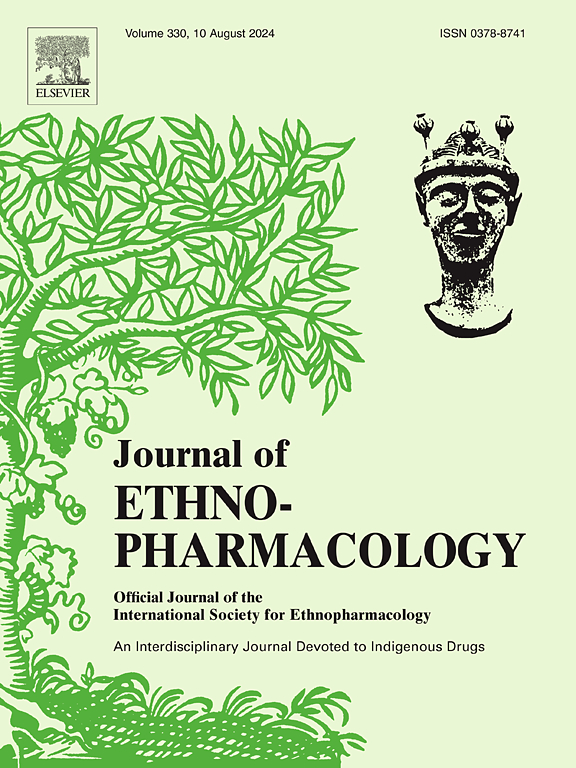Icariin维持tmem119阳性小胶质细胞群改善衰老小鼠海马相关记忆与r -3-羟基丁酸代谢的关系
IF 4.8
2区 医学
Q1 CHEMISTRY, MEDICINAL
引用次数: 0
摘要
民族药理学相关性:淫羊藿。黄芪是中国几千年来用来治疗健忘的传统中药。淫羊藿苷是淫羊藿属的主要成分。研究目的:探讨淫羊藿苷治疗健忘的代谢机制。材料与方法:采用d -半乳糖诱导衰老小鼠模型。在恐惧条件反射试验中评估小鼠的认知能力。免疫组化法评估海马病理。采用GC-MS法分析血浆代谢组,采用UPLC-MS/MS或GC-MS法进一步鉴定差异代谢物。采用酶反应法测定肝功能,包括ALT和AST。淫羊藿苷按50和100 mg/kg腹腔注射。小鼠每周连续用药5天,共8周。结果:伊羊藿苷治疗改善了海马相关的恐惧记忆,但没有改善杏仁核相关的记忆,而培西达替尼(PLX3397),一种小胶质清除剂,没有改善。Icariin处理维持了衰老小鼠大脑中tmem119阳性的小胶质细胞群,并减少了衰老生物标志物p16在海马背侧的积累,而PLX3397则没有。值得注意的是,与其他海马亚区相比,淫羊藿治疗小鼠的CA2亚区p16显著减少。衰老小鼠表现出轻度酮症酸中毒、三羧酸循环活跃、乳酸酸中毒、高血糖、解毒活跃、顺式油酸代谢活跃、GABA抑制关闭等循环代谢特征。主要在肝脏中产生的r -3-羟基丁酸被淫羊藿苷选择性地显著减少,而PLX3397没有观察到这一点。淫羊藿苷可恢复衰老小鼠的TCA循环。淫羊藿苷还能保护d -gal诱导的衰老小鼠的肝功能(血浆ALT)。结论:淫羊藿苷可能通过保护小胶质细胞稳态来保护小鼠海马认知功能免受d -gal诱导的衰老,促进r -3-羟基丁酸的利用是其基础之一。本文章由计算机程序翻译,如有差异,请以英文原文为准。

Icariin maintaining TMEM119-positive microglial population improves hippocampus-associated memory in senescent mice in relation to R-3-hydroxybutyric acid metabolism
Ethnopharmacological relevance
Epimedium Tourn. ex L. is a traditional Chinese medicine used for thousands of years in China to treat forgetfulness. Icariin is a principal component of the genus Epimedium.
Aim of the study
The metabolic mechanism of icariin treating forgetfulness is explored.
Materials and methods
A D-galactose-induced senescent mouse model was employed. The cognitive performance of mice was assessed in the fear conditioning test. Hippocampal pathology was assessed in the immunohistochemistry assay. Plasma metabolome was analyzed using GC-MS method, and the differential metabolites were further identified by UPLC-MS/MS or GC-MS method. The liver function, including ALT and AST, was assessed by enzyme reaction. Icariin was administered intraperitoneally at 50 and 100 mg/kg. Mice were administered five consecutive days per week for 8 weeks.
Results
Icariin treatment improved hippocampus-related fear memory but not amygdala-related memory, whereas Pexidartinib (PLX3397), a microglial scavenger, did not. Icariin treatment maintained the TMEM119-positive microglial population and decreased the accumulation of the senescent biomarker p16 in the dorsal hippocampus in senescent mouse brains, whereas PLX3397 did not. Notably, p16 in the CA2 subregion significantly decreased in icariin-treated mice than the other hippocampal subregions. The senescent mice exhibited the circulating metabolic characteristics of mild ketoacidosis, active tricarboxylic acid (TCA) cycle, lactic acidosis, hyperglycemia, active detoxification, active cis-oleic acid metabolism, and inhibitory GABA shut. R-3-Hydroxybutyric acid primarily produced in the liver was selectively and robustly decreased by icariin treatment, which was not observed with PLX3397 treatment. The TCA cycle was rescued in senescent mice by icariin treatment. Icariin also protected liver function (plasma ALT) in D-gal-induced senescent mice.
Conclusions
Icariin may protect mouse hippocampal cognition from D-gal-induced senescence by protecting microglial homeostasis, and facilitating the utilization of R-3-hydroxybutyric acid is one of the underpins.
求助全文
通过发布文献求助,成功后即可免费获取论文全文。
去求助
来源期刊

Journal of ethnopharmacology
医学-全科医学与补充医学
CiteScore
10.30
自引率
5.60%
发文量
967
审稿时长
77 days
期刊介绍:
The Journal of Ethnopharmacology is dedicated to the exchange of information and understandings about people''s use of plants, fungi, animals, microorganisms and minerals and their biological and pharmacological effects based on the principles established through international conventions. Early people confronted with illness and disease, discovered a wealth of useful therapeutic agents in the plant and animal kingdoms. The empirical knowledge of these medicinal substances and their toxic potential was passed on by oral tradition and sometimes recorded in herbals and other texts on materia medica. Many valuable drugs of today (e.g., atropine, ephedrine, tubocurarine, digoxin, reserpine) came into use through the study of indigenous remedies. Chemists continue to use plant-derived drugs (e.g., morphine, taxol, physostigmine, quinidine, emetine) as prototypes in their attempts to develop more effective and less toxic medicinals.
 求助内容:
求助内容: 应助结果提醒方式:
应助结果提醒方式:


